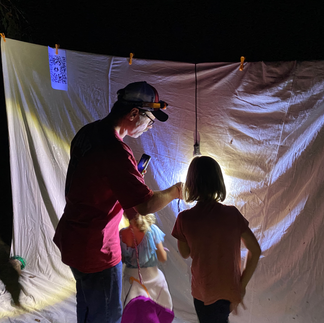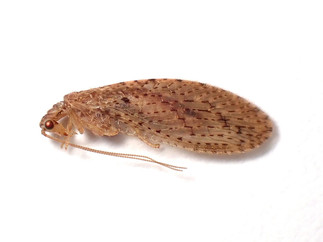Meet the Moth in the Adelaide Hills
- larissabrazsousa
- Apr 12, 2022
- 3 min read
Citizen scientists observing moths in South Australia have just reached over 7,000 observations of these charismatic creatures! The species list is also growing, with 671 different species recorded so far. With distinct colours, smooth legs and feathery antennae, these invertebrates have been the highlight of our past citizen science engagement activities.
Following the success of our previous Moth Nights (January and March editions), the teams from Ferox australis and Adelaide Hills Science Hub came together to organise a picnic night at the Mylor Oval. The event aimed to explore the nocturnal biodiversity from Adelaide Hills with an information session about moths and other pollinators.

Photos: Citizen science engagement at the Mylor Oval involved a night walk along the creek and a moth experience.
What an incredible night of biodiversity awareness and adventures! About 50 people attended, including families and several young explorers eager for observing moths. Besides exploring the local fauna and flora, attendees also contributed to 115 observations on iNaturalist, featuring 19 identified species - so far. This number might be much bigger after our friendly iNat community helps us identify all species observed that night.
Before we started the practical experience, Nicole Miller gave a talk about the importance of nature-based play and learning in schools to facilitate opportunities for kids to improve physical and mental health and form a relationship with nature. When encouraged in nature-based activities, children can have enhanced wellbeing, besides educational, engagement and social outcomes. Following her talk, Stephen Fricker explored the benefits of using iNaturalist to engage kids, families and all ages in citizen science and biodiversity awareness. He gave some tips on downloading it, creating an account, and starting using the platform to register all forms of flora and fauna.

Photo: Nicole talking about the importance of nature-based learning for school kids.
As the sun went down, families had an opportunity to go for a walk along the creek and have a play with iNaturalist to get familiar with it. The young explorers also had fun during the scavenger hunt activity. The children took the lead with their torches and recorded many observations on Seek by iNaturalist. They observed plenty of invertebrates, such as dragonflies, spiders, flies, bees, yabbies and even a frog!
Photos: Kids taking the lead in exploring the surroundings while doing the nature scavenger hunt activity.
Everyone could also learn from the local pinned invertebrates in the available displays. As the white sheets went up and the black UV lights came on, an incredible diversity of moths, crane flies, wasps, beetles and even a mozzie (great contribution to the Mozzie Monitors project!) showed up. The colourful and charismatic moths came in various sizes, being the highlight of the night. It was an excellent experience for all attendees to learn how to use iNaturalist in such a diverse environment. Find out what other species we discovered during the evening here.
Photos: Learning experience during citizen science activity moth night.
You may also want to check some stunning observations from our enthusiastic South Australian naturalist cobaltducks.
Photos: From the left to the right: Tasmanian Lacewing (Micromus tasmaniae); Longlegged Sac Spiders (Genus Cheiracanthium), Giant Willow Aphid (Tuberolachnus salignus); Ground Beetles (Family Carabidae); Striped Ladybird (Micraspis frenata); Genus Hednota.
It was a great night full of learning and new species added to our team's list on iNaturalist. More than that, it was an enjoyable experience, sharing the observations with so many inspirational kids and nature lovers. We are looking forward to our next moth night at the Bee Hub on April 29th. If you'd like to join us keep an eye on The GAINBioblitz Facebook page for the event, and register through our website.









































Comments